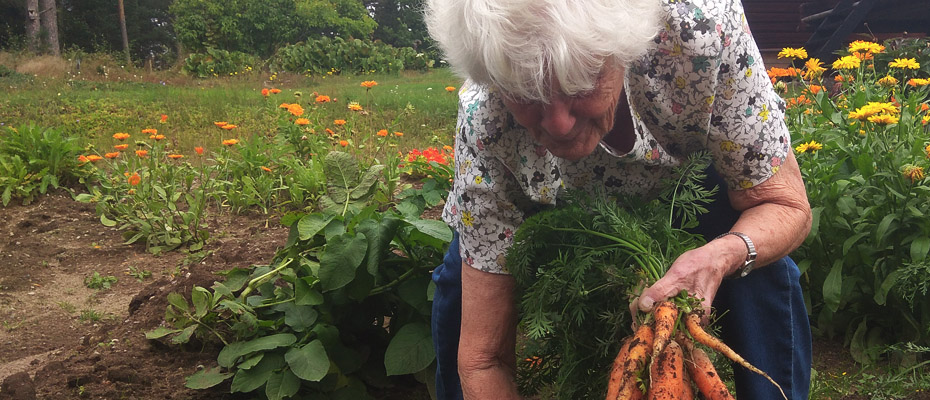Eat to live forever (or 97+)

Take care of your body. It’s the only place you have to live in.
Jim Rohn
I recently visited my grandmother in her summer house in the north of Sweden. She was busy picking apples and pulling the last carrots out of the ground before moving back to her city apartment where she spends the winters.
“Would you believe that I’ve been retired for more than 30 years already?”, she said to me one evening as we were watching a news clip about the lack of teachers in Swedish schools. “I would have been happy to put in another few years.” When my grandmother retired as a school teacher in the 1980’s no one talked about increasing the retirement age. Now most of us will probably work until we die, so there’s another reason to stay healthy.
Few people live as long as my grandmother, who turned 97 this year and is in excellent shape. She enjoys long walks, and she’s passionate about gardening. My uncle always says the house is what keeps her in such great shape, as it gives her something to look forward to during the winter months. For the winters in Sweden are long, dark, and lonely. This year she had potatoes, carrots and broad beans in the vegetable patch. Of course, there’s also the fruit trees, bushes full of berries, and more flowers than I could name. More than anything, my grandmother loves apples. She’s eaten at least one a day for her whole life, and often more when she picks them straight off the tree. Perhaps it’s true as they say, that an apple a day keeps the doctor away.
One night over dinner we got onto the topic of diet, and I asked her about what they ate when she was a child. She lit up. I’ve yet to meet an older person who doesn’t enjoy telling you what the world was like when they were young. She painted a picture of Sweden in the 1930’s, where the food landscape was very different from the one we know now.
“There was a lot of offal, liver was popular. We’d make our own black pudding and eat it together with pork. In the summers we’d raise rabbits in the garden. I remember, there was a layer of fat on those rabbits that we melted down and poured into jars. We’d take it out later, to use for baking. Nothing went to waste.”
Oil was never used for cooking, but margarine was common. They ate a lot of boiled potatoes and root vegetables, with staple foods such as swede mash and cabbage soup. Nightshade vegetables like tomatoes and peppers were not common back then. Neither was white bread. On Sundays, you might get a cinnamon bun, or a slice of sweet loaf if you were lucky.
It was rather crisp bread, more dear to the Swedes than the crown jewels, that was available alongside every meal. It keeps well, so I’m sure after we’ve all gone extinct alien anthropologists will find a box of the stuff and wonder what it was all about. That we were actually eating it will most likely not occur to them.
“Fish, there was a lot of fish. Especially after the war broke out. There was rationing, and we had to use coupons. I used to go for lunch at a place called The Milk Bar. I was a student and it was the cheapest place in town. For lunch they had a fish stew that was always full of bones. Until this day, I still struggle with fish bones. For breakfast they would serve porridge made from oats. I still eat a lot of porridge – it’s nutritious, honest food.”
I asked her about candy and processed foods. The only brands she could remember was Kellog’s and Kungsornen, an ancient Swedish brand of macaronis.
“On a rare occasion, you’d get licorice pipes, a danish pastry, or a chocolate bar. My father would sometimes bring home these giant oranges and we would all get so excited. They were really juicy. And I remember soft drinks back then, they were sold in the pharmacy. Imagine that,” she laughed.
Not only were people eating a lot less sugar back in the day, but also less refined carbohydrates. Apart from the milk-stewed macaroni from Kungsornen there wasn’t any pasta or rice in the Swedish pre-war diet.
My grandmother still doesn’t eat a lot of carbohydrates. The majority comes from porridge, apples and potatoes, and the portions are always small. What’s interesting is that she practices intermittent fasting eating two meals a day, usually within an eight hour window. Breakfast is either porridge or filmjolk -a fermented Swedish milk drink similar to kefir- with muesli and a spoonful of jam. With this goes a slice of crisp bread with butter and cheese, or liver pate, a popular sandwich topping in Sweden. Her next meal is not until dinner around 5 o’clock. Typically she eats meat, potatoes and vegetables in some variant of what is known as “Swedish husmanskost”.
Apart from the occasional apple or slice of cake, my gran never snacks. She doesn’t get hungry between meals. Her diet is relatively low in calories, most of them coming from fat. Generous lashings of butter go into everything she cooks. She clearly missed out on the low fat craze of the 90’s, when you might as well have been waving a bottle of arsenic if you tried to serve someone butter.
Moderation is key, or as my great-grandfather used to say: “Eat a little bit of everything.” The more I read on the topic, the more it seems to me that low calorie diets are linked with longevity. My grandmother’s way of eating supports this theory. Of course it also helps that she doesn’t drink alcohol, and hasn’t smoked a cigarette since prom night in 1942.